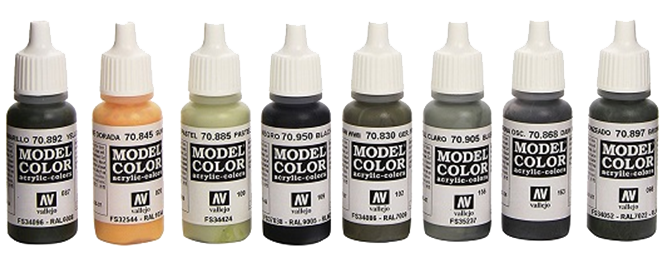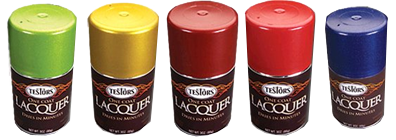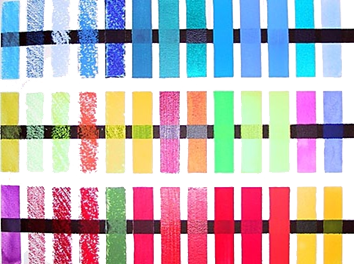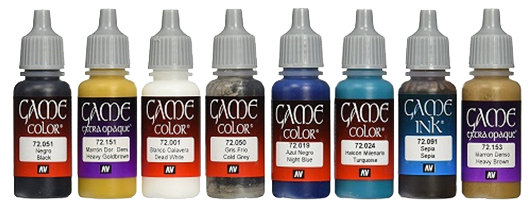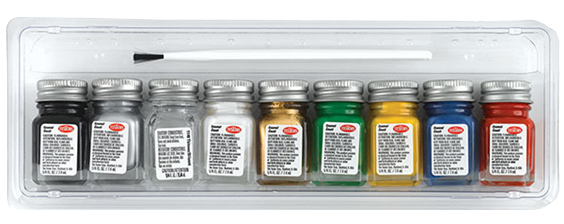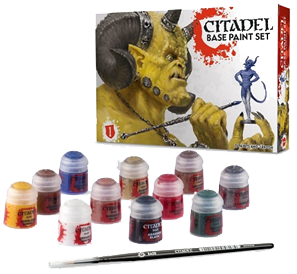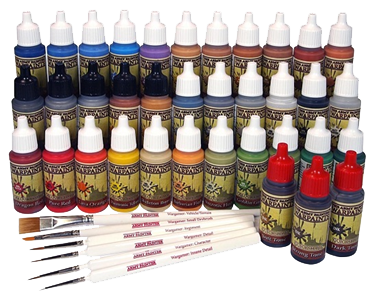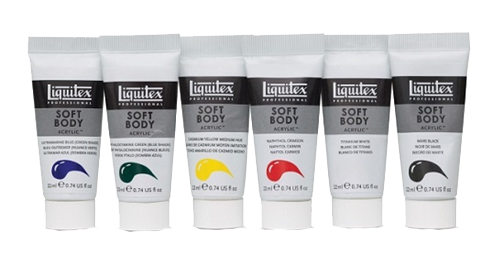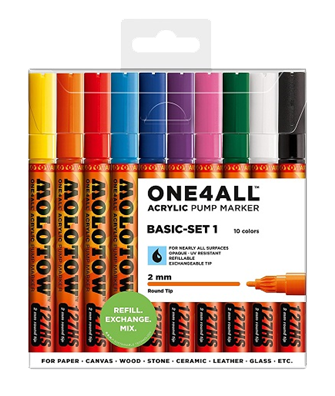SPRUEVERSE RESOURCES
A Guide To Model Paints
HOW TO CHOOSE YOUR PAINT
We’ve scoured the world wide web for information that will help you with your hobby – when we find posts or information we can endorse at sprueVerse it will be here for you. For those of us who have spent countless hours painting our miniatures or scale models, we know all too well the importance of using high-quality paint. Once you have a better understanding of paints and how they work on different surfaces, as well as the different types of paints available choosing the best paint for a given project will be much easier. One of the first decisions you will face is what type of paint you want to work with. Next, you will want to decide how you are going to apply it whether that is with a brush, airbrush, or less common but very convenient is the paint marker. Aside from this the rest of what you will want to know is what affects the performance of the paint on a given material whether it is plastic or metal.
TYPES OF PAINT
What kind of paint should I use for plastic models or miniatures? What type paint should I use for metal models? These are common questions and really comes down to preference. Paint typically consists of color pigment that is then emulsified with a binder that can be delivered to a paint medium, which for this purpose is usually plastic or metal. These binders will typically determine what the paint type will be. Below are the two types of paint available to hobbyists to use on models or miniatures. Aside from the binders, sometimes paint will have additional additives that affect performance but more on that later.
ACRYLIC BASED PAINT
Acrylic based paint is the most common and popular form of paint used on miniatures and plastic models and will achieve the best results in most cases. It is made by adding color pigment to an acrylic polymer then emulsified with water to create the final product. Acrylic paint can also contain various fillers that may or may not affect performance. Over the years acrylic paint has improved vastly and can now perform as good as oil-based paint in most cases. Some benefits are very short drying times, and the ability to change the flow or viscosity of the paint without diminishing the color saturation. Conversely, you can also change the transparency without changing the consistency. Acrylic paints are also incredibly easy to clean up as well as being non-toxic. In most cases, acrylic paint is the best choice for painting your miniatures or scale models. Acrylic-based paints can be brushed on, sprayed on, and can even be found in paint markers. Acrylic paint is also available in a variety of finishes or sheens ranging from glossy to flat.
OIL BASED/ENAMEL PAINT
Oil-based paint used to be the the most common form of pain this is until acrylic paints improved drastically to offer similar performance. Oil-based paints are those that mix pigment with a drying oil, typically linseed oil, as a binder. When oil-based paints are applied, the oil reacts with the air to dry to a very hard finish. These hard finishes are very durable and depending on the formula, can achieve a very glossy sheen. When used with turpentine or other thinners, oil-based paints can be thinned to change the viscosity and flow. The luminous properties, as well as its ability to bond to just about any surface, are just a few reasons some artists use oil-based paints. The downside of oil-based paints is the slow dry time, the need to use turpentine for cleanup which is both cumbersome as well as toxic. The slow dry time id not a total negative though since it can allow the artist more time to develop the paint job gradually but just as well you will need to wait longer when layering colors. As you can see, while either paint can work well on pretty much any type of application, you may be better off using acrylic over oil or vice versa. Another thing to keep in mind is using oil and acrylic paints that will touch or layer over one another isn’t advised as acrylic paint will not always bond to oil paints.
PAINT FORM & APPLICATION
Paints can be applied to miniatures and scale models in a number of ways of achieving a variety of effects. Some are more versatile while others can produce very unique designs and appearances.
LIQUID PAINT
Liquid paint is by far the most commonly used paint and is also more widely found at any craft store. It is readily available and there are many additives available to change both transparency and consistency to better suit your needs. Liquid paint is the most versatile form and is used for brushing, splattering, and even in airbrush systems to be sprayed on. Liquid paint is usually the go-to choice for most hobbyists. Liquid paint is available in both acrylic and oil bases.
PAINT MARKERS
I don’t often hear others discuss the use of acrylic paint markers when painting miniatures but they are a great item to have in your paint setup. They are extremely convenient and can cover a high volume of repetitive coloring that doesn’t require a high amount of precision. This is great for something like battle minions or amassing a collection of custom painted war soldiers for some wargaming. Paint markers won’t give you a ton of versatility but as stated above, great for convenience as well as touching up figures without the need to break out your entire paint setup. I always keep a few of these around in my most used colors.
SPRAY PAINT
There a few options available to you available in spray cans. This is not to be confused with airbrush spraying paint in which the paint is separate from the air and spraying source. You can check airbrushes for miniatures and scale models for more on that. A good use for spray cans is putting base coats onto your models and figures or spraying single colors down. You won’t be able to achieve the precision often required but when used in conjunction with masking you can achieve some effects.
OTHER CONSIDERATIONS TO SELECTING MODEL & MINIATURE PAINT
Paints have a few characteristics you need to be aware of in addition to the paint type and application method. These are other attributes that will also affect both the final appearance and application of the paint. Understanding this will help to achieve better results.
PAINT OPACITY
A paint’s opacity refers to how opaque or transparent a paint is when applied to a surface. This can produce both desired effects as well as determine how well the color shows up on surface. For dark colored surfaces you will need to use more opaque paint so the color is more visible and vibrant on top of the dark color. The alternative is needing to apply more coats to achieve a nice opaque color. Note a paint tubes transparency rating when buying. Paints that either transparent or opaque will work well on lighter colors. The lighter colored surface will lighten the tint of paints that. There are also additives like Flowable Extender which will improve a paints flow or slow drying time.
PAINT BODY & VISCOSITY
The body and consistency of paint will affect the application of the paint. A thin or body-less paint will work well in an airbrush system or for someone who desires a more watercolor-like consistency when painting. The most color-rich and opaque paints will contain mostly pigment and binder with small amounts of water. On the other end of the spectrum, heavy body paint is how paints are able to achieve textured or raised appearances when dried. You can achieve virtually any desired consistency using different additives, simply adding a little water can make the paint more flow. Keep in mind that any additives may affect the opacity of the paint particular in acrylic when water is used. There are a variety acrylic additives like these made by Liquitex that can change the flow of the paint or slow the dry time. Consider an additive if you need to achieve a particular effect.
LIGHTFASTNESS
High-quality paints will usually have a lightfast rating. This rating determines how susceptible the color will be to fading or shift due to light exposure. Look for paints that are described as being lightfast to ensure a long-lasting paint job.
ARTIST PAINTS VS MODEL/MINIATURE PAINT
Artist quality paints are usually made of the highest quality materials and the highest concentrations of pigment. Paints marketed as “Model Paint” or “Miniature Paint” are really not too different at all. Any difference is usually in auxiliary additives that are included in “model paint” that are there to produce effects like slowing dry times. Since a manufacturer’s paint formulas are generally trade secrets we will never really know what they contain but as a general rule, artist quality paints are usually superior. You may be wondering which is better but the debate continues and I usually tell people to use what works for them. There is a case for either if you are an artist who already has a stock of paints to use I wouldn’t recommend buying all new paints. If you are just starting out, model paints sets offer a great variety of sets in pre-selected colors which are formulated to provide great results even for the novice. If you do use artist-grade, select light-bodied lines or thin them when using.
COLOR SHIFT
Color shift is a natural effect of color darkening as it dries. Acrylic resin is generally white and dries darker than it appears. This is why it is a good idea to test paint before painting an entire piece. Artist quality acrylic use clear resin so their color shift is imperceptible and any color shift is due to the combination of surface color and a paint’s opacity. Finally, the best paint should not be without the best paintbrushes. Once you decide on your paint, quality paintbrushes are equally important in laying smooth color. Since you have a better understanding of what makes great paint you can set out to find one that works best for your needs. We have also provided several choices of the best miniature and scale model paint.
THE BEST PAINT FOR MINIATURES & MODELS – QUICK REVIEWS
Below is a complete list of the best paints for both miniatures and scale models available. We have included an option for each type of paint which should provide unlimited capabilities when painting on plastic, metal, and other materials. From acrylic based paints to oil-based enamels, you will find one on the list. If you are heading to your local craft store, some of the best paint brands are going to be Vallejo, Game Workshops, and Liquitex among others.
VALLEJO BASICS >
One of the most well-known brands among miniature painter, Vallejo offers an impressive 200+ colors for an artist to choose from. The combination of available colors and their highly pigmented, specialized formula which adheres well to just about any surface is what makes Vallejo one of the best miniature paints available which are just as great for models. The sets are pricey but being able to choose color pallets tailored to the project is convenient. Another great thing about the Vallejo paint is how well they work in airbrush systems so there is no need to purchase additional paint just for that, you only need a bit of acrylic thinning medium. If you just want to be able to pick up a set of paints that are trusted among scale model builders than the Vallejo paint line is your best bet for both performance and color selection.
Key Features
- Acrylic based
- Excellent color selection which highly opaque
- Formulated for all surfaces
TESTORS ENAMEL PAINT >
If you are looking for a great oil-based enamel paint for that hard durable finish, Testors Enamel is a great option that scale model enthusiasts have used for years and years. While enamel paints aren’t for everyone, if you are one of the few specifically looking for oil-based, there aren’t many options available other than Testors but luckily it is excellent paint. Another area where these excel is airbrushing, Testors enamel paints are one of the best model airbrush paints available. This paint is popular among automobile and aircraft modelers as they adhere to virtually any surface and produce a wonderful luster of rich color. This paint also produces a nice finish that dries smoothly free of brush strokes. This is due to the slow drying of the paint. You can also thin the paint easily with oil-based thinner to create light washes. A tried and true paint for modelers for decades!
Key Features
- Oil based
- Vibrant and opaque color
- Excellent in Airbrush Systems
- Use on any surface
GAMES WORKSHOP CITADEL >
Another popular option among painters of miniatures is the Citadel lineup form Games Workshop. Like the Vallejo paints, you can find many different sets tailored to specific paint jobs you may encounter when painting miniatures. These are great quality paints in terms of opacity and coverage. Compared to Vallejo some painters feel that they fall just behind but others have nothing bad to say, in the end, it is mostly preference. If you are still trying to find a paint that suits you these are certainly worth a try.
Key Features
- Acrylic Base
- Opaque with great coverage
- Great selection of custom sets
THE ARMY PAINTER PAINT SET >
The Army Painter set is the best miniature paint set for beginners there is. This set comes with an incredible amount of colors, as well as a few washes and technical paints, and paintbrushes which is everything you need to get started. While the quality may not be quite as good as Vallejo it is still good enough for even discerning eyes. With the range of colors, you will very easily be able to create a range of different miniatures in a variety of color schemes helping you build a diverse collection of soldiers for your next wargaming match. One tip to improve your experience and convenience with The Army Painter paints is to put small ball bearings into the bottles to help mix the pigment if separation occurs
Key Features
- Acrylic Based
- Large color set
- Great for beginners
LIQUITEX PROFESSIONAL SOFT BODY PAINT >
If you find yourself doing more than just miniature painting the Liquitex Professional Soft Body paint is a great option for miniatures and models. It provides a great balance of affordability for artist grade paint and quality. Liquitex paints perform excellently on most surfaces and can be great for base coats in solid colors or paint large areas of terrains in battle scenes. The other benefit of the artist grade paints are the quantity available to you is much greater. Without fear of wasting expensive paints, you can do more testing and experimenting with these paints. The one major edge model and miniature specific paints will have is specific color availability and tailored sets. You can certainly mix up custom colors with the available options. Give these a try if you like experimenting or paint other mediums as well.
Key Features
- Bodiless Acrylic Base
- Transparent
- Can be used in Airbrush Systems
- Mixable with other Jacquard Textile lines
- Fabric: natural and synthetic fabrics, wood, paper, clay, canvas, suede, leather
MOLOTOW PAINT MARKER >
One item I also keep in my paint kit is a few paint markers in basic colors. Molotow is one of the best choices for modelers and miniatures as they offer some of the best pigment concentration and are refillable making them a lasting investment. One thing you will see with the Molotow is that even though the consistency is typically thinner in paint markers these still offer great coverage and opaque performance. They are convenient and handy for touch-ups or even certain details. These paint markers perform quite well on a variety of surfaces but work best on surfaces that aren’t too smooth and provide a bit of tooth for the paint to adhere to. Finally, if you prefer working with enamel, Testors Enamel Markers are also some of the best model paint markers as well. Give paint markers a try, they are sure to become a mainstay in your paint setup.
Key Features
- Acrylic Base
- Opaque with good coverage
- Refillable







